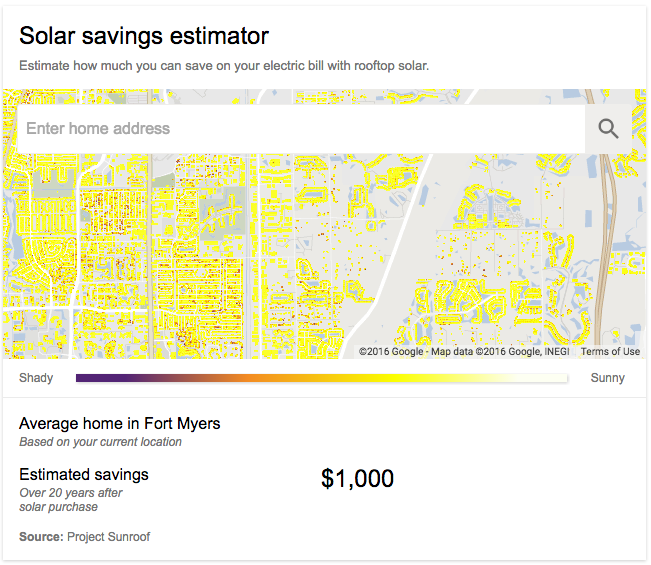For those of you that haven’t heard of Google’s Project Sunroof, it is a fantastic free service from Google that shows the rooftop solar potential of home in almost every state. It seeks to estimate how much solar energy you can produce at home. It goes one step further and helps you find an installer.
The tool will help you estimate the savings from a solar electric system, also known as solar photovoltaic system, or sometimes called just solar panels.
The question is, how valuable is it and is it accurate?
Can You Trust It?
You might have stumbled across Project Sunroof accidentally. If you type in “Solar Panels” as a google search term, you may be presented with a panel at the top of the search results. This is called the Solar Savings Estimator by Google. It gives an estimated savings for a home with solar power in your approximate location. It looks like this:

Source: Project Sunroof Solar Savings Estimator, Google.com, August 22, 2016.
What does this mean? What is an average home in Fort Myers? How does it know?
Clearly this tool is making a wild estimate. Homes vary in size by many multiples. Roofs vary. Property shading differs.
Most importantly, nothing is in perspective without knowing how much the system costs. How much will you need to spend to save the reported $1,000. How much roof space do you need? How does that relate to your electric bill?
What Does The Solar Savings Estimator Tell You?
Don’t get too excited (or not excited) about the results. The estimated savings are just a placeholder. The $1,000 figure doesn’t mean much. I mean, how many solar panels does that represent? What roof orientation? The results are very speculative and suspect.
The number is just a ballpark. It’s a starting point.
To get a better idea, you need to enter an address into the search bar. This yields some interesting results. I entered a home address in Fort Myers, FL for a typical home, and below is the result that appeared.

Source: Project Sunroof, Google.com, August 22, 2016.
The first thing that stands out is that Project Sunroof highlights the roof surfaces where solar power is most viable. While it apparently ignores several shading issues, it does highlight the best roofs. It also shows roofs that have obvious tree shading as poor performers.
However, suddenly the annual savings jumped to $4,000 – 4 times the previous estimate. It’s hard to tell where this number originates. The Up-front cost figure is also pretty nebulous. It’s in the ballpark for the cost of a typical system, but it’s unclear how many panels it represents.
There are still more question than answers.
Real Savings
With the numbers presented by Project Sunroof’s solar savings estimator, it appears that a prospective buyer would have to shell out $33,000 and would reap $153 per month in savings. Quick math reveals a payback period of over 17 years. That sounds pretty high, and most people would not pursue an investment like that.
There are several problems with this analysis:
- The up-front cost figure would easily yield more in savings than the calculator suggests based on today’s prices.
- The roof can accommodate far more solar panels than the up-front cost suggests.
- The up-front costs can vary significantly based on the type and quality of equipment installed.
- It is apparent that the calculator uses an average installed system cost that is not accurate for the local area.
In reality, if you spend $33,000 after incentives, you will likely recoup well over $200 per month on average over 20 years based on the 2.2% annual energy escalation factor used by Google. This assumes you can buy a 13.5kW system for that price.
The numbers just don’t add up.
Conclusion
Google’s Project Sunroof is really cool. In fact, it’s amazing. Using aerial imagery and proprietary tools, it comes up with some fantastic and useful data previously unavailable. However, this data is better used on a macro level in our opinion.
While the tool gets consumers excited and interested in solar energy, it also has the potential to turn people away. Technology is not ready to replace your local solar professional, and can’t duplicate an on-site analysis. In fact, it can’t even replace an analysis performed by a trained eye using aerial imagery.
As an aside, the Project Sunroof calculator does not support solar thermal systems like solar pool heaters.
Google isn’t lying to you. They are giving consumers an analysis based on assumptions, which is what we do every day. We just question whether those assumptions are valid and useful. Surely you can get better information from a trusted solar contractor that does this every day.
Here is a fun fact… the home shown above actually has a solar energy system that would cost $24,500 after incentives today. The system produces about $140/month in electricity today, and it as electricity rates increase it is expected to contribute about $180 per month on average over its lifetime. That blows Google’s numbers out of the water.
While Google’s Project Sunroof is a very cool tool, whether you can trust it is up for debate.
